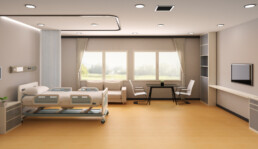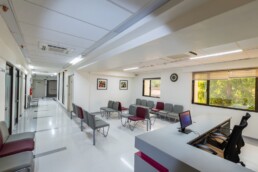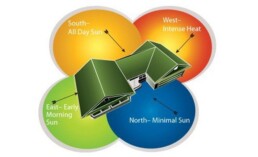Targeted Care, Focused Design: The Emergence of Single-Specialty Hospitals
The single-specialty healthcare market in India, constituting about 15% of the overall healthcare sector, is showing remarkable growth. It is projected to grow at over 12% CAGR, potentially reaching around USD 37.3 billion by 2026. Initially dominated by eye and dental care, this segment now includes growing fields like fertility, dialysis, and oncology. Attracting over USD 2 billion in private capital funding in the past 12 years, the sector is appealing for its asset-light and investment-friendly nature.
With this evolving landscape, understanding the implications for healthcare design becomes crucial. As single-speciality centres grow, their design needs become more specific, calling for tailored solutions in healthcare architecture and planning to cater to their unique requirements and patient demographics.
Rising Popularity of Single-Specialty Care Centres
By concentrating on one medical field, single-speciality hospitals offer a more stable and clear design brief than multi-speciality hospitals. Their services are rooted in specific operational premises, leading to more efficient planning and design. This makes them an increasingly preferred choice in the healthcare landscape. Let’s take a deeper look at their advantages.
1. Medical Planning Efficiency
In single-speciality hospitals, understanding functional relationships and requirements is more straightforward. This clarity aids medical planners and architects in streamlining workflows, optimising space utilisation, and reducing redundancies, unlike the complex trade-offs often encountered in multi-speciality hospitals.
2. Enhanced Patient Experience
Single-speciality hospitals cater to a more homogeneous patient group, enabling a more personalised and practical approach to patient experience. For example, an Ophthalmology centre might integrate braille into its design, while an Orthopedics facility could provide specialised walking aids, tailoring the environment to specific patient needs.
3. Branding and Identity
Single speciality hospitals, often part of a network, offer unique branding opportunities. The integration of interiors and branding can be more cohesive, enhancing the hospital’s identity and patient perception.
4. Efficient Execution and Cost Management
The smaller scale of single-speciality hospitals typically results in shorter construction timeframes and controlled budgets. The clarity from the project’s inception leads to fewer design and construction changes, streamlining the execution process.
5. Operational and Capital Efficiency
These hospitals can often be established in existing buildings, reducing the need for new, large-scale construction. This adaptability, combined with efficiency in design and operation, translates into significant capital cost savings and potentially higher returns on capital expenditure.
Over the last few years, healthcare organisations have demonstrated a tendency to protect and refurbish their existing structures or utilise redundant facilities instead of constructing completely new spaces. Our blog article “Repurpose And Resuscitate!” highlights the reasons behind this growing trend!
Designing Single Speciality Centres
With its clear advantages, let’s learn more about how healthcare designers evaluate and build these spaces.
1. Understanding the Specialization
Specialisation in healthcare design is not just about aesthetics; it’s about creating spaces that cater to the specific needs of different medical practices. For instance, an ophthalmology clinic requires precise lighting conditions for examinations, while a fertility clinic needs a serene environment to ease patient stress.
We should approach each speciality with a keen understanding of its unique requirements, ensuring that every design element, from room layout to lighting, is tailored to enhance patient care and staff efficiency
Kshititi Nagarkar, Shree Designs
2. Needs Assessment
A thorough needs assessment lays the foundation for a successful design. This involves detailed consultations with medical professionals to understand the nuances of their practice. For a dental clinic, this might mean ensuring ample private spaces for consultations and state-of-the-art dental chairs. The goal is to balance functionality with comfort, ensuring that the space meets the technical demands and creates a welcoming atmosphere for patients.
Find out more about how we integrate features for dental clinic designs in our blog linked here: Designing A Dental Clinic For Success
3. Site Selection and Planning
The choice of location significantly influences the design and functionality of a healthcare facility. Factors like accessibility, proximity to other medical services, and even the local climate play a crucial role. For instance, designing a rehabilitation centre in a tranquil, natural setting can aid patient recovery. Healthcare architects carefully evaluate each site, ensuring that it not only meets logistical requirements but also complements the therapeutic objectives of the facility.
4. Patient-Centred Design
Patient comfort is paramount. This goes beyond aesthetics; it’s about creating a healing environment. For a paediatric ward, this could involve using bright, cheerful colours and including play areas to make the space less intimidating for children.
It’s time to inject some playfulness and get rid of the cold sterility in inpatient environments! When we introduce colour and light to brighten up healthcare facilities for children, we can vastly improve their experience. Find out how in our blog linked here! 5 Best Ways To Create Healing Spaces For Kids
On the other hand, In designing senior facilities, the priority would be on safety and comfort with a focus on fall prevention, infection control, and clear wayfinding. Non-slip flooring, strategically placed handrails, and senior-friendly furniture layouts are employed to minimise fall risks. Infection safety is addressed through easy-to-clean surfaces and advanced ventilation systems.
Learn how to keep your healthcare facility clean and sterile with our in-depth blog 5 Design Tips To Keep Your Healthcare Facility Safe And Sterile
For easy navigation, the design incorporates intuitive layouts, high-contrast signage, and visual cues, enhancing both independence and security for seniors. This holistic approach ensures a safe, comfortable, and dignified living environment for elderly residents.
Our blog article Navigational Design In Hospitals dives deep into the strategies behind effective wayfinding and navigation in healthcare facilities.
5. Functional Design
A well-designed healthcare facility optimises the workflow, enhances patient care, and improves staff efficiency. This involves strategically placing medical equipment, designing intuitive patient navigation paths, and ensuring privacy in treatment areas.
For instance, in an urgent care clinic, the design would focus on minimizing wait times and providing rapid access to care.
To find out how to create spaces that are not just visually appealing but are also highly functional and efficient, read our insightful blog: Patient-centric Clinic Designs
6. Technology Integration
Departments like pathology, radiology and cardiac cath labs primarily depend on large-scale equipment or analysers.
In integrating technology into healthcare design, architects must ensure the infrastructure aligns with the needs of sophisticated systems. For instance, installing an MRI machine or CT scan requires specific environmental conditions, like controlled temperature and humidity, and robust electrical and data connections. Architects must also consider the machine’s weight and size, ensuring the facility can support it structurally. Healthcare design experts streamline these processes, ensuring that the facility accommodates these high-tech machines and optimises their functionality.
Learn how design helps set up specialised centres like cardiac cath labs and ICUs in our blogs linked here:
3 Lessons Learned While Building A Cardiac Cath Lab | Shree Designs
3 Essential Design Features For Intensive Care Units
Conclusion:
Single-specialty hospitals are marking a significant shift in healthcare, blending focused medical care with thoughtful design. This approach not only caters to specific patient needs but also reflects global trends towards specialised healthcare.
If you’re embarking on a healthcare architecture and design project and looking for a partner that understands the nuances of effective budget management and quality assurance, reach out to Shree Designs. Let us help you make your vision a reality, ensuring your project not only meets but exceeds expectations.
Learn more about our process through our case studies and completed projects.
Related Posts
Infographic,Designing Healthcare Facilities
Blueprint for Healthcare Design
From room dimensions to lighting levels, every detail matters in healthcare design. At Shree…
Designing Healthcare Facilities
Building Better Day Surgery Centres
Efficient care, happier patients, and smarter workflows - this is what defines a successful…
Project Management,Designing Healthcare Facilities,Infographic
Designing Healthcare Spaces That Truly Heal
From concept to completion, every medical space we design prioritizes patient flow, staff…
Designing Healthcare Facilities
The Business of Wellness
In the $1.8 trillion wellness industry, first impressions matter. Patients don’t just choose a…
Designing Healthcare Facilities
Efficient Hospital and Clinic Design
India’s emerging cities are growing rapidly, creating an urgent demand for accessible and efficient…
Designing Healthcare Facilities
Creating Calming and Confidential Spaces for Fertility Clinics
As the demand for fertility treatments grows, the architecture of these clinics plays a vital role…
Designing Healthcare Facilities
Designing the Perfect Hospital Pharmacy
Hospital pharmacies are the backbone of seamless patient care. From efficient workflows to secure…
Designing Healthcare Facilities
Preventive Care Facility Design Strategies
With preventive care emerging as the future of healthcare, this post outlines key architectural…
Designing Healthcare Facilities
Thermal Comfort Decoded
Thermal comfort plays a critical role in patient recovery, staff productivity, and overall…
Designing Healthcare Facilities
Building for Tomorrow: The Imperative of Adaptable Healthcare Design
Healthcare facilities need to be as dynamic as the industry itself. Traditional, rigid designs can…
Designing Healthcare Facilities
Innovative Design Solutions for Senior Care Facilities
Designing senior-friendly spaces in healthcare facilities is crucial for catering to the evolving…
Designing Healthcare Facilities
Designing a Dental Clinic for Success
Providing quality dental care is not just about the technical elements of the treatment. It's also…
Designing Healthcare Facilities
3 Essential Design Features for Intensive Care Units
ICUs are not just limited to single units housing all critical patients. If the facility has…
Designing Healthcare Facilities
3 Lessons Learned While Building a Cardiac Cath Lab
Cardiac care design is moving at the sound of a new beat! The number of Cath labs in India has…
Designing Healthcare Facilities
5 Essential Elements of Healthcare Design
Design makes a significant impact on the delivery of care for both healthcare providers and…
Designing Healthcare Facilities
5 Best Ways to Create Healing Spaces for Kids
Designing spaces in healthcare facilities tailor-made for children is a lesson in balance! A…
Designing Healthcare Facilities
Top 5 Trends in Healthcare Design
Design can make all the difference when it comes to improving patient care. From a patient’s point…
Designing Healthcare Facilities
The Architectural Design of Hospital Facilities
Shree Designs designed and executed many efficient and safe healthcare setups in the middle of the…
Designing Healthcare Facilities
Dauntless Designers
Healthcare Radius in its 7th Anniversary Special issue in October 2019, featured a "power list of…
Designing Healthcare Facilities
The changing face of healthcare design
After completing a decade in designing healthcare projects, Kshititi Nagarkar, principal architect,…
Designing Healthcare Facilities
Thumb Rules for Planning and Designing of Hospitals
Traditional rules of thumb in healthcare planning have changed. Once-accepted rules can now be the…




















